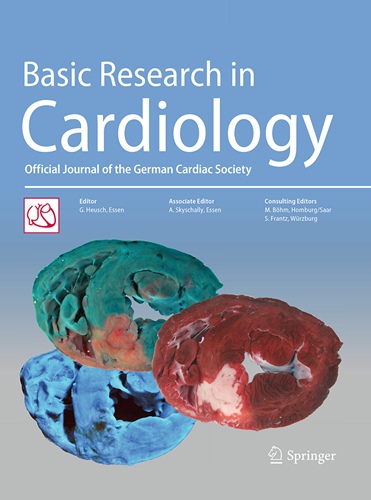心肌缺血/再灌注损伤后延髓吻侧腹外侧区儿茶酚胺神经元的激活驱动心室重构。
IF 8
1区 医学
Q1 CARDIAC & CARDIOVASCULAR SYSTEMS
引用次数: 0
摘要
儿茶酚胺神经元在延髓吻侧腹外侧(RVLM)一直被认为是一个重要的神经元群参与心血管调节。然而,其在心肌缺血再灌注损伤(MIRI)后心室重构中的功能及其相关回路尚不清楚。在这项研究中,我们研究了RVLM儿茶酚胺能神经元的潜在作用,以及驱动MIRI和MIRI后心室重构发展的潜在机制。体内电生理记录显示,RVLM神经元的自发尖峰率在MIRI过程中增加。嗜神经病毒示踪表明RVLM儿茶酚胺能神经元接受室旁核(PVN)的谷氨酸能投射。具体来说,这些RVLM儿茶酚胺能神经元直接投射到脊髓神经节前神经元,然后投射到星状神经节,这是两个调节心血管活动的关键神经节点。此外,抑制与RVLM儿茶酚胺能神经元相关的神经回路可抑制心脏交感神经活动,从而预防MIRI并减轻MIRI后4周心室重构的严重程度。我们的研究结果表明,从PVN到RVLM儿茶酚胺能神经元的谷氨酸能投射是脑-心轴调节MIRI和潜在减轻心室重构和随后的心力衰竭的重要而独特的机制。本文章由计算机程序翻译,如有差异,请以英文原文为准。
The activation of catecholamine neurons in the rostral ventrolateral medulla drives ventricular remodeling after myocardial ischemia/reperfusion injury.
Catecholamine neurons in the rostral ventrolateral medulla (RVLM) have long been recognized as a crucial neuronal population involved in cardiovascular regulation. However, its function and related circuits in ventricular remodeling after myocardial ischemia/reperfusion injury (MIRI) remain unclear. In this study, we investigated the potential role of RVLM catecholaminergic neurons and the underlying mechanisms that drive MIRI and the development of post-MIRI ventricular remodeling. In vivo electrophysiological recordings revealed that the spontaneous spike rate of RVLM neurons increased throughout MIRI. Transneuronal tracing with neurotropic viruses indicated that the RVLM catecholaminergic neurons received glutamatergic projections from paraventricular nucleus (PVN). Specifically, these RVLM catecholaminergic neurons project directly to the spinal preganglionic neurons and then to the stellate ganglion, which are two critical neural nodes that regulate cardiovascular activity. In addition, inhibition of the neural circuit associated with RVLM catecholaminergic neurons suppresses cardiac sympathetic activity, thereby preventing MIRI and lessening the severity of ventricular remodeling at 4 weeks after MIRI. Our findings suggest that glutamatergic projections from PVN to RVLM catecholaminergic neurons are important yet distinctive mechanisms of the brain-to-heart axis in regulating MIRI and potentially mitigating ventricular remodeling and subsequent heart failure.
求助全文
通过发布文献求助,成功后即可免费获取论文全文。
去求助
来源期刊

Basic Research in Cardiology
医学-心血管系统
CiteScore
16.30
自引率
5.30%
发文量
54
审稿时长
6-12 weeks
期刊介绍:
Basic Research in Cardiology is an international journal for cardiovascular research. It provides a forum for original and review articles related to experimental cardiology that meet its stringent scientific standards.
Basic Research in Cardiology regularly receives articles from the fields of
- Molecular and Cellular Biology
- Biochemistry
- Biophysics
- Pharmacology
- Physiology and Pathology
- Clinical Cardiology
 求助内容:
求助内容: 应助结果提醒方式:
应助结果提醒方式:


